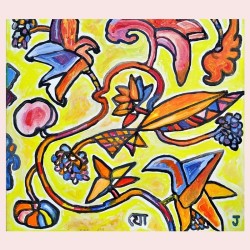Jogen Chowdhury
b 1939
Educated at the Government College of Art & Craft, Calcutta and subsequently at Ecole Nationale Superieure des Beaux Arts, Paris, Jogen is one painter who has inspired young artists of contemporary India, in a significant way. R. Siva Kumar, the reputed art historian, has lucidly described Jogen's works in the following excerpt:
The pulse and rhythm of Jogen Chowdhury's art comes from a filial affinity to nature and milieu. In Chowdhury's more recent works the sensory experiences of cloth, bolsters, sofas and the human body are cross-projected to produce an uncanny world of tran-substantiated tumescence and flaccidness. Mnemic displacements and personal associations add to the symbolic ambivalence of his motifs, making his images come closer to inexplicable experiences than to explicit signs. In the postures of some figures we feel an animal sentience, in the ripe anatomy of others we savour a fruity succulence. The figures are wrought by a combination of decorative willfulness and expressive distortion and are imbued with an effusive sensuality. Chowdhury's art is rich in suggestions; it is to be apprehended without bracketing our fund of knowledge, experience or memories, but also cannot be narrativised without trivializing it, without depleting its sensory particularities.
Jogen Chowdhury has been widely acknowledged to be, the master of the unbroken line. Like Leger, Chowdhury has been stirred by the linear Kalighat pat tradition, but his lines are emotive and used to express and suggest the character of a person. This is done by, distorting the form without breaking the line and in the world of young, contemporary art, distortion has been Jogen Chowdhury's most significant impact. Perhaps, because of this, a common observation of his work is that his "people" are caricatures. The person feels familiar to the viewer but it is far more individualised - the face is imaginary but the psyche or characteristics are real. The power and beauty of his technique and line is this play between the known and unknown. In Jogen Chowdhury's work, the figure is always in the foreground, it is primary, it conveys everything. He uses colour to give volume to his figures and the fluidity of his lines bring a sensual aspect to his forms.
Chowdhury is fascinated by history. Having experienced the traumatic effects of the Partition, dislocation and a sense of isolation, his figures reflect an intractable solitude. Even when he paints a couple, the two are detached and distant from each other. His individual figures are usually more sensuous - the woman caressing herself, if a man, then curled in pain with raw wounds on his body. His imagery is organic and emerge as protuberances or growths from within. Chowdhury's works are also social and political comments; he either protests or sublimates the injuries to or of the human condition. Jogen Chowdhury's ability to juxtapose contrary emotions, the real and imaginary and the known and unknown, make his art not only a form of self expression but a reflection, of a collective and subjective consciousness.

